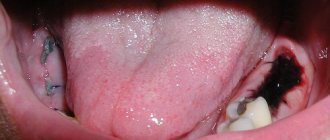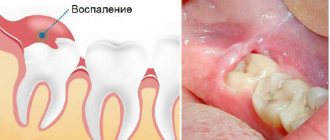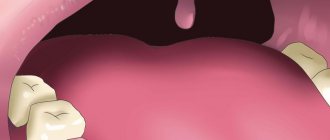23.12.2020 66482
Anyone, sooner or later, may need a tooth extraction. This occurs due to its severe destruction, progression of the inflammatory process and other reasons.
Typically, doctors use removal surgery only as a last resort, when other means are ineffective. It is important to understand that the procedure is a surgical operation that must be carried out carefully and in compliance with all safety requirements.
In this material we will touch on an important issue - the rehabilitation period. We will talk about how long it takes for the gums to heal after tooth extraction, and what rules should be followed to prevent complications from occurring. Compliance with simple safety requirements will not only significantly speed up recovery, but also ensure the safety of your health.
How much does tooth extraction hurt the gums?
Assessing how severe the harm from tooth extraction will be is not always easy. Sometimes removal can take much longer and have a very negative impact on the condition of a person’s gums. And here it doesn’t really matter which doctor performs the procedure - there are many potential complications.
Among the most notable factors of injury are the following:
- Rupture of the ligaments and muscles that hold the tooth. They help the tooth stay inside the socket and not become loose over time.
- Tissue damage. We are talking about both periodontal and periodontal tissues. They can heal for quite a long time.
- Impact on the vascular system and nerves. Serious damage to blood vessels and nerves can usually occur. It is precisely because of the likely contact of blood with pathogenic bacteria during the recovery period that it is important to observe hygiene standards.
When going through the recovery process, you should be prepared for the fact that signs characteristic of inflammation will be observed for some time. In this case, swelling may appear, the temperature of the tissue at the site of removal may increase, and bleeding may occur. Pain also becomes a frequent companion during the recovery period.
In our clinic, removal is performed as carefully and carefully as possible. The extensive experience of doctors allows us to minimize tissue damage and reduce trauma. We will also answer the question of how long it takes for gums to heal and how to properly care for the socket so that it heals as quickly as possible.
What else can pain indicate?
Severe pain after removal may indicate the development of complications. Pulsating pain that radiates to the ears and submandibular lymph nodes is not normal. The most common causes of complicated postoperative pain are the following factors:
- Violation of treatment protocol. Unfortunately, mistakes do occur, especially in the removal of complex teeth. The techniques and approaches used in different clinics may differ from the standards. Errors include leaving fragments of materials or a splintered tooth root behind.
- Alveolitis. Occurs in the absence of a blood clot. The disease complicates natural healing and interferes with normal tissue regeneration. That is why doctors do not recommend touching the wound with your tongue or rinsing your mouth intensively.
- Dry hole. One of the common complications and the cause of long-term pain after tooth extraction. Despite the moisture of the mucous membranes, bone tissue is visible at the bottom of the wound opening. This problem is typical for smokers during periods of hormonal surges. The doctor seals the wound with a swab containing medication.
- Trigeminal neuritis. Long-term pain persists when a tooth in the mandibular row is removed if the trigeminal nerve is damaged during the manipulation. Damage may be accidental due to structural anomalies or multiple branching of nerve structures.
The likelihood of complications developing is low if the removal protocol, medical recommendations after extraction, and timely response to alarming manifestations are followed.
The main stages of socket healing after tooth extraction
It is impossible to clearly predict how long the hole will take to heal. The individual characteristics of the human body, the type of tooth and the characteristics of the operation are of great importance. Typically, it takes more time to restore a hole after the removal of a tooth with a large number of roots and the need for additional manipulations - creating an incision in the gum and others.
In some cases, during the removal process, crumbling and splitting may occur - then the gums will be injured even more.
Conventionally, several main stages of healing can be distinguished:
- Reduced bleeding. Depending on the characteristics of the patient’s body, the gums should stop bleeding after 2-3 hours. Some people take a little longer. If the bleeding does not stop, you should immediately consult a doctor. But this is a rare occurrence unless the patient has problems with blood clotting.
- Formation of a blood clot in the socket. It is very useful because it does not allow bacteria that cause diseases to enter the wound. You cannot remove such a clot - bleeding will open, there is a high risk of inflammation and resumption of bleeding.
- Appearance of a film on the clot. This is a white coating of the epithelium. Gradually it covers more and more space. Between the fourth and seventh day after surgery, the entire clot should turn white.
- Formation of epithelial tissue. Occurs between 20 and 24 days after surgery. The gums from the outside will be the same as next to healthy teeth - color, texture.
When the patient follows the dentist’s instructions and treats the hole carefully, there should be no complications or any problems.
Why does a pulled out tooth hurt?
The presence of pain after tooth extraction is due to the fact that soft tissues, blood vessels and nerves are damaged during tooth extraction. Typically, the first pain symptoms appear 3-4 hours after surgery. This is due to the fact that this is when the anesthesia stops working.
Also, during removal, the bone tissue of the jaw socket may be damaged. In this case, the pain during the healing period is more intense and prolonged. However, if the removal was carried out correctly, it will soon pass.
How long does it hurt?
In most cases, pain during removal worsens on the second day. On the third day they begin to decrease. By the fourth or fifth day, there is practically no pain. If by this period the pain after tooth extraction does not subside, the patient should consult a doctor, as this may indicate the emergence of complications.
However, it is important to remember that complete healing of the hole occurs only in the second or third week after the procedure. Until this time, the gums and bone tissue are vulnerable, so if they are irritated, pain may also occur. To prevent this from happening, you should follow your doctor's recommendations.
Headache
The recovery period after tooth extraction may be accompanied by headaches of varying intensity. They are associated with damage to the nerve fibers that go to the brain. Such symptoms should not frighten the patient, since as the wound heals, they will also pass.
Another cause of headaches during this period may be hypertension. The patient must notify the attending physician about the presence of such an illness. In this case, the surgeon will be able to select appropriate medications that will reduce pain.
Ear pain
For the same reasons, a patient may experience unpleasant or even painful sensations in the ear after tooth extraction. Most often they have a shooting character. This symptom is also normal and goes away in the coming days after the intervention.
Ear pain may worsen if, after the procedure, the patient does not properly care for the oral cavity and tries to chew solid food.
Pain in the gums
Pain in the gum is associated with its direct damage. In this case, not only the soft tissue suffers, but also the nerves, which are also located in the gums. Depending on the degree of damage, pain can last for different times and occur with greater or less intensity.
Increased pain in the gum may indicate the presence of fragments in its tissues, as well as the occurrence of one or another complication. If such symptoms occur, you should immediately consult a specialist.
Features of the gum restoration process
Sometimes patients wonder if there are any differences in the recovery process, depending on what kind of surgery was performed on the patient. The answer is yes, there are such features. Let's consider three main variants of the situation.
Standard tooth extraction
When a person is healthy, the removal went well, and the tooth itself was not classified as complex, the restoration process begins immediately.
The recovery process takes longer if the tooth was large and a wide wound appears in its place. In this case, the dentist will apply stitches. They last on fabric for 7-8 days, sometimes less or more. Throughout this time, you may feel pain or signs of an inflammatory process.
After 3-4 weeks, most patients experience complete restoration of the gums. The pain goes away, swelling is relieved, and the periodontium heals. Bone tissue begins to form, and from the outside the removal site already looks quite healthy.
Removal before prosthetics
Sometimes tooth extraction may be necessary before prosthetics can be performed. The dentist makes this decision when restoration or the use of special orthopedic structures is impossible.
The removal is done with a view to installing an implant or bridge, which the old tooth will only interfere with. A periosteum augmentation process may also be required. It is more common when teeth are removed from the upper jaw, when there is simply not enough tissue for normal implant placement.
The augmentation procedure significantly increases the recovery time. It is difficult to predict the timing here; you need the attending physician to carefully monitor your condition.
Wisdom tooth removal
The most complex and difficult to predict removal process is wisdom tooth extraction. It is necessary if the tooth grows at the wrong angle, interferes with its neighbors in the dentition, and can cause irritation and other problems.
With this type of operation, the gums can be severely damaged. There are several reasons:
- A large number of roots. They can cause significant damage to your gums during the removal process. Sometimes resection may be required.
- The wisdom tooth is often hidden behind the gum. In this case, an incision will need to be made and exposed before removal can be carried out.
- Often the tooth is located at an angle. He can strongly push against his neighbors. At the same time, the dentist decides how to reduce the pressure and not damage other teeth.
After removal, the gum is not in the best condition and may require stitches. This means that the hole will take longer to heal.
Why is tooth extraction required?
In certain cases, tooth extraction is the only possible method of solving a particular dental problem. Indications for removal may include:
- Incorrect position of the tooth, when neither the patient nor the doctor can access it (high-quality hygiene and/or treatment is impossible);
- The absence of the main part of the dental material without a chance of its restoration;
- Malocclusions (for example, severe crowding);
- Inflammatory process in the roots of the tooth, which can lead to infection;
- Painful eruption of wisdom teeth.
This is also necessary when preparing to correct your bite using Invisalign aligners. In particular, it is usually necessary to remove the “eights” if they have not fully erupted and can interfere with quality orthodontic treatment. It is worth noting that such a decision should be prepared when there are certain indications and no other option is possible.
Otherwise, when installing aligners, the unerupted tooth hidden inside the gum will prevent the aligner from attaching and pull the remaining teeth in the right direction, leaving them no room to move.
Reasons for long gum healing
Typically, the answer to the question of why gums take a long time to heal is related to the individual characteristics of the human body, as well as infection.
The addition of a secondary infection can be observed against the background of several common problems:
- The patient violated the requirements for proper gum care. Often the problem lies in the fact that too much caution has been exercised and the quality of oral hygiene has decreased.
- The wound was not properly cleaned. When patients turn to dentists with a low level of skills, there is a high probability that a tooth fragment or a piece of cotton wool will remain in the hole. This can cause serious problems and greatly increase the duration of the recovery process.
- An injury occurred. It is worth watching exactly how you handle the hole. So doctors recommend avoiding any friction, strong pressure and other mechanical irritations.
Any dentist will tell you that removal is best done when the person is completely healthy. Regeneration time may increase if there are diseases of the oral cavity, stomatitis. You should also be wary of sinusitis and sore throat - they can complicate the recovery process.
Why can the socket become inflamed?
As mentioned above, one of the main conditions for proper tissue healing is the presence of a blood clot, which prevents infection of the wound and its mechanical damage. However, in some cases, the hole becomes inflamed and painful, which indicates the onset of complications. This can happen for the following reasons:
- a complex operation was performed, during which it was necessary to injure the soft tissues too much,
- a phenomenon called “dry socket” formed. There is a violation of the integrity of the protective clot or its complete loss due to non-compliance with doctor’s instructions, excessively intense rinsing of the mouth, damage to the socket with a brush or hard food,
- removal was carried out in conditions of acute infection, for example, with periodontitis or periodontitis with complications,
- There were common provoking factors, including weak immunity, blood clotting problems, older age and lack of proper hygiene.
“Dry socket” after tooth extraction
When faced with such problems, it is important to react in time. If you notice signs of inflammation and pus discharge, you must do everything possible to urgently see a specialist.
How to make regeneration faster
To make the recovery period shorter, you should treat the hole as carefully as possible. Several central means help speed up regeneration:
- Brush your teeth correctly. It is important that the oral cavity is cleaned properly and that pathogenic bacteria that can cause inflammation and other problems do not multiply in it.
- Use antiseptics. They need to be rinsed after eating. But from the side of the extracted tooth, you should not rinse your mouth too much, creating a vacuum inside the mouth.
- Try not to put pressure on the gum so that the socket is constantly at rest. Strong mechanical pressure and other similar effects on tissue are especially dangerous.
Socket bleeding
Socket bleeding most often appears immediately after surgery, although sometimes several days pass between tooth extraction and the onset of bleeding.
Bleeding from the socket of an extracted tooth can occur for several reasons:
- The patient actively disturbs the socket of the extracted tooth - he feels it with his tongue or hands, inaccurately brushes his teeth or aggressively treats the sore spot with an irrigator;
- Physical damage in the socket area - gum injury, fracture of the alveoli, and so on;
- Concomitant diseases of the patient: hypertension, leukemia, etc.
Treatment for alveolar bleeding depends on the cause and source of bleeding.
Healing of the hole
If the gums bleed in the area of the socket, then the problem may be complications after surgery, and the wound will need to be stitched.
If blood comes from the vessels directly in the walls of the socket of the extracted tooth, then it is first cooled, after which the vessels are compressed and a tampon with a hemostatic agent is placed in the socket for 4-5 days.
If local remedies do not give the desired effect, the dentist prescribes the patient to take general hemostatic agents.
Main treatment methods
Your dentist will tell you what treatment and gum care should be like after tooth extraction. Only he can select the right drugs that are suitable specifically for your case.
Among the most common treatment methods are the following:
- Careful rinsing with preparations and tinctures with various herbal ingredients and antiseptics.
- Local application of soothing ointments and gels.
- Drug treatment. Your doctor may prescribe antibiotics, painkillers, and anti-inflammatory drugs. But we do not recommend using any medications without a prescription.
How does a postoperative wound heal?
How long the area hurts after tooth extraction depends on many factors. The healing process after tooth extraction is a complex and lengthy process. Removal occurs with a rupture of the dentofacial connection, namely the connection with the alveolar process and the jaw bone.
The recovery process lasts about two to three weeks. Much depends on the surgical protocol, the clinical situation and the characteristics of the body.
Main stages:
- Formation of a blood clot. Forms 1.5-3 hours after extraction. The function of the clot is to protect the wound area from pathogens and secondary infection.
- Active tissue regeneration. The affected mucous membranes are restored, after 3-4 days swelling and inflammation decrease.
- Formation of granulation tissue. After 4-6 days, granulation tissue forms on top of the clot - the basis of a new epithelial layer.
- Granulation proliferation. After a week, the granulation tissue grows, completely covering the socket.
Already on the eighth to tenth day, the wound is completely healed and by the end of the second week a new epithelial layer is formed.
After two weeks, bone tissue begins to renew. After six months, the bone tissue in the area of removal becomes completely healthy.
Can there be complications after tooth extraction?
The issue of complications always worries patients. But if you do not have concomitant infectious diseases, and the operation is performed by an experienced doctor, the risk is very small.
There are several common likely problems:
- Hematoma at the site of removal.
- Severe swelling of the cheek.
- Numbness in the area near the extracted tooth.
- Bleeding.
In some cases, flux may also appear. Dentists should be careful when administering anesthesia. If you do not make sure that the patient does not have an allergic reaction to the drug, you may encounter a number of problems.
Natural processes
Even if the tooth extraction was “simple”, pain in the socket at the site of the extracted tooth is a natural consequence that will bother you for 3-4 days.
This is normal and nothing to worry about, but if the pain causes you severe discomfort, consult your doctor and he will recommend that you take painkillers.
Sometimes regular cold compresses applied to the cheek in the area of the extracted tooth will help relieve pain. This could be a cloth soaked in cold water or ice from the freezer wrapped in a cloth.
Tooth socket
In the case of “complex removal”, in which the gums were cut and sutured, special tools were used to gouge out the root, the pain after the procedure will be felt much longer (the doctor will definitely warn you about this), but will still gradually go away on its own.
If the pain does not go away for more than ten days, consult your doctor: there may be complications in the tooth extraction and you will need dental intervention to eliminate them.
How to properly care for your gums
To prevent complications from occurring, you should follow a few simple recommendations:
- Do not heat the gum. Strong heat can stimulate the spread of the inflammatory process.
- Use a soft brush. At the same time, when brushing your teeth, try not to touch the gums at the extraction site.
- Use additional cleaning products. These include irrigators and dental floss.
- Try to use toothpastes with soothing herbal ingredients.
It is very important not to self-medicate. If any problem arises, you should consult a doctor as soon as possible.
When to see a doctor
The sooner you see a doctor if you notice signs of inflammation, the easier and faster the problem can be solved. Since, in the normal course of events, pain and swelling disappear within 2-3 days, a good reason to urgently consult a dentist would be an increase in the symptoms present a couple of days after removal. The absence of a clot in the hole, swelling of the tissues, increasing pain and a suspicious-colored coating are the main signs indicating undesirable processes. In such a situation, you cannot hesitate - you need to immediately go to the doctor.
- According to WHO.
Types of pain relief
There are three types of anesthesia in dental practice:
- Local – anesthesia of the oral cavity using a syringe and an anesthetic. This type of anesthesia is used most often. Local anesthesia is performed in several ways depending on the indications.
- Sedation is a superficial depression of consciousness using mild sedative intravenous drugs. Sedation puts the patient into a state of sleep, eliminates fear and anxiety, and allows treatment to be carried out in a comfortable environment for the patient and the doctor.
- General anesthesia is anesthesia that involves influencing the central nervous system. In clinical practice, anesthesia is used quite rarely. It is used in cases where treatment with other methods of pain relief is impossible.
Local anesthesia provides pain relief to the teeth, gums, jaws and soft tissues of the mouth. It comes in several types depending on the methodology:
- Conduction – anesthesia of large nerve endings at the points where the nerve exits the bone. It is used when necessary to numb the entire jaw or part of it. This type of anesthesia is used during surgical operations, implantation, and tooth extraction.
- Intraosseous – injection of an anesthetic into the bone tissue of the jaw. It is performed more often for additional pain relief at the intervention site.
- Infiltration – gradual introduction of an anesthetic solution into the soft tissues of the maxillofacial area. First, the drug is injected under the mucous membrane, then into the deeper layers of tissue. The anesthesia acts quickly, is easy to administer, and can be injected if necessary.
- Intraligamentary – injection of an anesthetic into the tooth ligament and periodontal fissure. It is used to numb one tooth using a special syringe.
- Application – superficial anesthesia of the mucous membrane using cream, gel, spray. Most often used in pediatric dentistry. It can be performed before anesthesia using a syringe to eliminate pain during injection.
There are two types of anesthesia: local and general.
Local anesthesia includes:
- topical anesthesia, which is used in the form of gels and sprays (used to anesthetize the mucous membrane, for example, during the procedure for removing dental plaque), it lasts for ten to twenty minutes;
- infiltration anesthesia (used for the treatment and removal of teeth most often in the upper jaw and the frontal group of teeth in the lower jaw) lasts for one and a half to two hours;
- conduction anesthesia (for complex surgical procedures and dental treatment in the area of the lower chewing teeth) lasts for two or more hours.
- intraligamentary or intraligamentous anesthesia. This type is done extremely rarely, as a rule, when it is impossible to perform other types of anesthesia.
- intrapulpal anesthesia is used as an additional type of anesthesia during root canal treatment; the feeling of numbness of the tooth occurs quickly and practically stops by the end of treatment.
With all these types, the person is in a state of wakefulness.
General anesthesia includes inhalation and non-inhalation anesthesia. The first option includes anesthesia by mask anesthesia or intubation anesthesia, the second option includes intravenous anesthesia, neuroleptoanalgesia, ataralgesia and a combined method of using local and general anesthesia. In both cases, the person is in a state of sleep, but this type of anesthesia is not used in our dental clinic.
The duration of anesthesia is influenced by many factors, e.g.
- type of anesthesia;
- the correctness of anesthesia and the qualifications of the doctor (since if the injection is performed incorrectly, the anesthetic may have a weak effect, or even may not have any effect at all);
- what anesthetic is used;
- does the anesthetic contain epinephrine (adrenaline) and, if so, in what dilution (the higher the adrenaline content, the longer the effect of anesthesia);
- the amount of anesthetic administered (the larger the dose of anesthetic, the longer the anesthesia lasts);
- on which jaw the anesthesia is performed (since in the area of the upper jaw the bone is more porous and the numbing effect itself occurs quite quickly and sensitivity also returns quickly; in the area of the lower jaw the bone is denser, so here the numbness occurs longer, but this effect also lasts longer).
In our clinic, the main anesthetics used in the dentist's chair are Ultracaine and Ubistezin. Both anesthetics exist in adrenaline dilutions of 1/200,000 and 1/100,000.
Let's now figure out when and in what dilution they need to be used.
At a dilution of 1/100,000, it can be used by all people for infiltration and conduction anesthesia, except for patients:
- with hypersensitivity to anesthetic;
- with diseases of the cardiovascular system (coronary heart disease, tachycardia, arrhythmia, history of myocardial infarction, etc.);
- pregnant, lactating and children;
- with chronic kidney and liver diseases;
- with chronic diseases of the gastrointestinal tract;
- with caution if you have a history of epilepsy.
All of the above are the main absolute and relative contraindications to the administration of an anesthetic with a high content of adrenaline; such patients are administered anesthetics in a dilution of 1/200,000 or without any adrenaline (for example, Mepivacaine).
An important factor in the duration of anesthesia is the person himself:
- If there is an inflammatory process at the site of future manipulation, then the duration of action of the anesthetic is reduced due to the fact that an acidic environment predominates at the site of inflammation, in which the anesthetic is destroyed more quickly;
- If the patient comes excited, overexcited, with fear in his eyes from the upcoming procedure, then the effect of anesthesia will increase, since the content of adrenaline in the body will increase, which constricts blood vessels, which means the anesthetic will be removed from the body more slowly;
- Depending on the age of the patient, the duration of anesthesia also varies. For example, in older people, blood vessels are less permeable, which means that anesthesia will take less time and be less effective;
- Eating fatty foods and alcohol before a dentist visit puts a strain on the liver, which slows down the removal of the anesthetic from the body;
- In chronic liver and kidney diseases, the anesthetic is eliminated from the body more slowly, since they are responsible for removing the anesthetic from the human body.
What needs to be done to ensure that the anesthetic is removed from the body faster and the anesthesia wears off faster:
- While there is a feeling of numbness, you should not eat solid or tough food, so as not to bite your cheeks and lips while chewing, but you can drink. It is recommended to take a warm drink, such as water, tea, warm compress, etc. (not hot, so as not to burn the mucous membrane). Thanks to this, the blood vessels will dilate and the anesthetic will be eliminated from the body faster. However, after tooth extraction, this method cannot be used so as not to cause bleeding from the socket of the extracted tooth;
- The day before the dentist’s appointment, do not drink alcohol or fatty foods in order not to burden the liver, which is responsible for removing the anesthetic from the body;
- To reduce fear and anxiety, you need to take a sedative;
- If the feeling of numbness does not go away within a day or more, then you should immediately consult a dentist.
Treatment and removal - is there a difference in pain relief?
There are 3 types of anesthesia most commonly used:
- application;
- infiltration;
- conductor.
Freezing during tooth extraction is mainly conductive, since it turns off large nerve trunks and lasts longer, about several hours. Teeth are treated primarily with infiltration anesthesia, the effect of which lasts from 15 minutes to 1 hour.
Applications are used to perform small procedures, often in children. Local application of Lidocaine 10% can only numb the injection site. Therefore, it can hardly be called freezing.
The type of anesthesia is determined based on which area needs to be numbed. For example, freezing when treating teeth on the upper jaw and in the area of the lower incisors is usually infiltrative: an injection is made into the transitional fold area of the diseased tooth.
Attention!
Infiltration anesthesia can also be used when removing upper or lower anterior teeth. Therefore, sensitivity in these places usually returns faster.
The transitional fold is located on the border of the lower part of the gum and the mobile mucous membrane of the cheek or lip. After administration of the medicine, an infiltrate is formed here - a kind of depot, from which the anesthetic quickly spreads to the jaw bone.
As for conduction anesthesia, it is used not only for removal, but also for treatment, especially of molars. This is due to the properties of the structure of the mandibular bone - it is more dense and voluminous. Moreover, the density and dimensions increase closer to the corners of the jaw.











